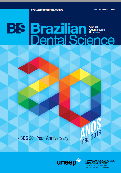Effect of several repair techniques on the bond strength between composite resin and degraded Y-TZP ceramic
DOI:
https://doi.org/10.14295/bds.2018.v21i4.1596Resumo
Objective: To evaluate the bond strength of different repair treatments for composite resin to aged Y-TZP ceramics. Material and Methods: Zirconia blocks were cut into smaller specimens, sintered according to manufacturer’s recommendations (final dimensions of 4×4×3 mm), and randomly allocated into nine groups (n=15) according to the surface treatment and presence/absence of aging of the substrate (subjected to low-temperature degradation - LTD), as follows: without LTD (Control: without treatment; TBS: tribochemical silica coating + silane + adhesive); with LTD (Control-LTD: without treatment; TBS-LTD: TBS with hydrothermal degradation; MoS-LTD: Monobond S + adhesive; MoP-LTD: Monobond Plus + adhesive; MZP-LTD: Metal/Zirconia Primer + adhesive; USB-LTD: Single Bond Universal; AP-LTD: Alloy primer + adhesive). LTD was simulated in an autoclave (134 °C, 2 bar, 5 h). The ceramic blocks were embedded in PVC cylinders with a self-curing acrylic resin; each surface treatment protocol was performed; a composite resin cylinder (Æ: 3.25 mm and height: 3 mm) was then build-up using split metallic matrices. All the specimens were aged (thermocycling + storage in water for 90 days) and subjected to the shear bond strength test using a universal testing machine (1 mm/min). The failure mode was classified into four types: adhesive, composite resin cohesive fracture, ceramic cohesive fracture, and mixed. The bond strength values were subjected to Mann–Whitney test. Results: Only air-abraded samples (TBS and TBS–LTD) survived thermocycling. More than 80% of the samples of the other groups presented pre-test failures. TBS groups presented higher values of bond strength (3.94) compared to TBS-LTD (0.96). The predominant type of failure for the surviving samples were adhesive. Conclusion: Air particle abrasion is mandatory to improve the bond strength of the Y-TZP substrate; an aged substrate presents an even more unfavorable scenario for adhesion.
Keywords
Dental prosthesis repair; Hydrothermal degradation; Zirconia; Shear bond strength; Sandblasting.
Downloads
Downloads
Publicado
Como Citar
Edição
Seção
Licença
TRANSFERÊNCIA DE DIREITOS AUTORAIS E DECLARAÇÃO DE RESPONSABILIDADE
Toda a propriedade de direitos autorais do artigo "____________________________________________________________________" é transferido do autor(es) para a CIÊNCIA ODONTOLÓGICA BRASILEIRA, no caso do trabalho ser publicado. O artigo não foi publicado em outro lugar e não foi submetido simultaneamente para publicação em outra revista.
Vimos por meio deste, atestar que trabalho é original e não apresenta dados manipulados, fraude ou plágio. Fizemos contribuição científica significativa para o estudo e estamos cientes dos dados apresentados e de acordo com a versão final do artigo. Assumimos total responsabilidade pelos aspectos éticos do estudo.
Este texto deve ser impresso e assinado por todos os autores. A versão digitalizada deverá ser apresentada como arquivo suplementar durante o processo de submissão.




























